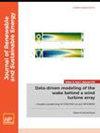钨硼酸杂多酸催化木质素液化:产品产量和组分分布
IF 1.9
4区 工程技术
Q4 ENERGY & FUELS
引用次数: 0
摘要
钨硼酸盐杂多酸催化剂具有良好的催化降解性能,尤其适用于生物质中 C-C 键的选择性裂解。本文研究了钨硼杂多酸(BW12)催化木质素液化在不同温度(120、140、160、180 和 200 ℃)、催化剂用量(0、2.5、5、10 和 20 wt.%)和反应时间(0、30、60、90 和 120 min)下的产物产率和组分分布。研究发现,在合适的反应条件下(180 °C、60 分钟、5 wt.%),可以获得较高的转化率(72.16 wt.%)和生物油产率(68.41 wt.%)。生物油分析表明,BW12 催化剂对生物油馏分的分布有显著影响,与未使用催化剂的生物油馏分相比,其中的单芳烃成分从 32.96% 增加到 47.56%。尤其是单芳烃成分中的羰基物质从 18.66% 增加到 26.97%。光谱分析(傅立叶变换红外光谱)发现,与未加工的木质素相比,BW12 催化的液化残渣中 C-O 和 C-C 键的吸收峰有所降低。此外,还通过 DFT 模拟研究了 BW12 催化木质素解聚的机理。模拟结果表明,木质素中 Cα-O 键的缩短、Cβ-Cγ 和 Cα-Cβ 键的断裂促进了香草醛和 3-羟基-4-甲氧基苯甲醛的形成。最后,根据实验数据和模拟结果,提出了 BW12 催化木质素液化成单芳香族物质的可能反应途径。本文章由计算机程序翻译,如有差异,请以英文原文为准。
Tungstoborate heteropolyacid-catalyzed lignin liquefaction: Product yield and component distribution
Tungstoborate heteropolyacid catalysts have good catalytic degradation performance, especially for selective cleavage of C–C bonds in biomass. In this paper, the product yield and component distribution of tungstoborate heteropolyacid (BW12)-catalyzed lignin liquefaction were investigated at different parameters, including temperatures (120, 140, 160, 180, and 200 °C), catalyst amount (0, 2.5, 5, 10, and 20 wt. %), and reaction time (0, 30, 60, 90, and 120 min). It was found that a higher conversion (72.16 wt. %) and bio-oil yield (68.41 wt. %) could be obtained under suitable reaction conditions (180 °C, 60 min, 5 wt. %). Bio-oil analysis showed that the BW12 catalyst had a significant effect on the distribution of bio-oil fractions, in which mono-aromatic components increased from 32.96% to 47.56% compared to those without the catalyst. In particular, carbonyl substances in the mono-aromatic components increased from 18.66% to 26.97%. Spectroscopic analysis (FT-IR) found that the absorption peaks of C–O and C–C bonds in the liquefied residue catalyzed by BW12 decreased compared to the raw lignin. Moreover, the mechanism of BW12-catalyzed lignin depolymerization was investigated by DFT simulations. The simulation results demonstrated that the shortening of Cα–O bond, the breaking of Cβ–Cγ and Cα–Cβ bonds in lignin promoted the formation of vanillin and benzaldehyde, 3-hydroxy-4-methoxy. Finally, based on the experimental data and simulation results, a possible reaction pathway for the BW12-catalyzed liquefaction of lignin into mono-aromatic substances was proposed.
求助全文
通过发布文献求助,成功后即可免费获取论文全文。
去求助
来源期刊

Journal of Renewable and Sustainable Energy
ENERGY & FUELS-ENERGY & FUELS
CiteScore
4.30
自引率
12.00%
发文量
122
审稿时长
4.2 months
期刊介绍:
The Journal of Renewable and Sustainable Energy (JRSE) is an interdisciplinary, peer-reviewed journal covering all areas of renewable and sustainable energy relevant to the physical science and engineering communities. The interdisciplinary approach of the publication ensures that the editors draw from researchers worldwide in a diverse range of fields.
Topics covered include:
Renewable energy economics and policy
Renewable energy resource assessment
Solar energy: photovoltaics, solar thermal energy, solar energy for fuels
Wind energy: wind farms, rotors and blades, on- and offshore wind conditions, aerodynamics, fluid dynamics
Bioenergy: biofuels, biomass conversion, artificial photosynthesis
Distributed energy generation: rooftop PV, distributed fuel cells, distributed wind, micro-hydrogen power generation
Power distribution & systems modeling: power electronics and controls, smart grid
Energy efficient buildings: smart windows, PV, wind, power management
Energy conversion: flexoelectric, piezoelectric, thermoelectric, other technologies
Energy storage: batteries, supercapacitors, hydrogen storage, other fuels
Fuel cells: proton exchange membrane cells, solid oxide cells, hybrid fuel cells, other
Marine and hydroelectric energy: dams, tides, waves, other
Transportation: alternative vehicle technologies, plug-in technologies, other
Geothermal energy
 求助内容:
求助内容: 应助结果提醒方式:
应助结果提醒方式:


